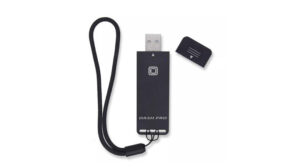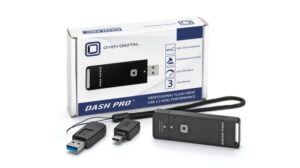Storage Has Come a Long Way
Remember when a 128MB USB stick felt like a treasure chest? You could tuck it into your pocket, carry around term papers, maybe a few songs, and brag to your friends that you had “so much space.” Fast forward to today, and those little thumb drives look more like keychain decorations than serious storage devices.
Digital files have ballooned in size. A single minute of 4K video can eat up hundreds of megabytes. Shoot RAW photos on a modern camera and you’ll burn through gigabytes before lunchtime. Even family life has gone digital home movies on your phone, sprawling photo collections, music archives, and entire movie libraries. All of that needs a home.
And yes, portable storage has tried to keep pace. So what’s the biggest USB drive you can buy right now? The answer is pretty staggering.
Meet the 4TB Oyen Digital Dash Pro

If you’re looking for sheer size, the crown currently belongs to Oyen Digital’s Dash Pro 4TB USB drive. Four terabytes, tucked into a device small enough to lose between your couch cushions.
To put that in perspective:
-
4TB can store about 1,000 full-length HD movies,
-
or over 1.2 million high-quality photos,
-
or roughly 1 million songs.
That’s not a typo. We’ve gone from a pocketful of essays to carrying an entire entertainment library or a professional-grade media archive in a flash drive.
Who Is Oyen Digital, Anyway?

You might be wondering if this is one of those sketchy, no-name drives that pop up in online marketplaces, claiming impossible capacities before failing at the worst time. But Oyen Digital isn’t a fly-by-night brand. They’ve been around for years, carving out a niche in professional storage solutions.
The Dash Pro 4TB isn’t a gimmick; it’s marketed as a pro tool for people who actually need it: filmmakers, photographers, and media pros handling massive files every single day.
Speed Matters: Why the Dash Pro Isn’t Just About Size
Storage is one thing, but speed is another. Anyone who’s ever waited 20 minutes for a video file to transfer knows that raw space isn’t enough. The Dash Pro uses USB 3.2 Gen2 technology, which translates into some seriously fast performance:
-
Up to 1,050 MB/sec when connected via USB-C, Thunderbolt 3, or Thunderbolt 4.
-
Around 525 MB/sec with USB-A 3.0.
To put it in everyday terms, transferring a 20GB 4K movie could take seconds instead of minutes. That’s a lifesaver if you’re working on tight deadlines or juggling terabytes of raw footage.
It’s also built with a Phison E21 controller, weighs just two ounces, and plays nicely with Windows, Mac, and Linux. The included USB-A and USB-C connectors add versatility, handy if you’re constantly swapping between different computers and setups.
The Price Tag: $409 of Pocket-Sized Storage
Of course, all that power comes at a cost. The Oyen Digital Dash Pro 4TB currently retails for around $409.
For comparison:
-
SanDisk Extreme Pro 2TB USB drive → about $180.
-
Buffalo 2TB USB drive → about $140.
You could buy two 2TB drives for less money than a single Dash Pro. So why would anyone pay the premium? The answer is convenience and workflow. Carrying one 4TB stick is easier (and less risky) than juggling multiple drives. If you’re working with time-sensitive projects or frequently on the move, that simplicity is worth paying for.
How Does It Stack Up Against Other Storage Options?
Here’s the thing: while 4TB is the biggest USB drive available, it’s not the biggest portable storage overall.
-
External hard drives can stretch up to 30TB.
-
External SSDs can climb to 8TB.
So why choose a USB flash drive at all? Portability. Flash drives are smaller, lighter, and don’t need external power. Slip one into your pocket, hang it from a lanyard, and you’ve got instant access to your data anywhere.
That’s why USB drives remain popular despite the rise of cloud storage and massive SSDs. They hit a sweet spot of size, speed, and simplicity.
Should You Buy the 4TB Dash Pro?
That depends on what kind of user you are.
Great for Professionals
-
Filmmakers working with 4K or 8K footage.
-
Photographers shooting in RAW who churn out thousands of files per shoot.
-
Designers and engineers are working with enormous project files.
For these people, the Dash Pro isn’t a luxury. It’s a tool that saves hours of waiting and reduces the stress of swapping drives mid-project.
Probably Overkill for Casual Users
If your daily storage needs are Word docs, spreadsheets, and the occasional slideshow, a 4TB USB drive is like buying a tour bus to drive your kids to school. Even if you’re a media lover with a healthy photo and music collection, a 1TB or 2TB USB stick will likely cover you for years, at a fraction of the cost.
That said, some everyday users like the idea of future-proofing. With files only getting bigger, owning a 4TB stick means you won’t outgrow your storage any time soon.
Looking Ahead: The Future of Flash Storage
Here’s what really stands out about the Dash Pro: it proves how far flash storage has come. Just ten years ago, the idea of a 4TB thumb drive would’ve sounded like science fiction.
It also makes you wonder: how much bigger can these things get? Will we see 8TB or even 16TB flash drives in the next decade? Probably. As storage technology shrinks and speeds climb, flash drives may continue to be the pocket-sized workhorses of digital life.
But there’s another question worth asking: do we even need them? Cloud storage continues to expand, offering terabytes of space accessible from anywhere with Wi-Fi. External SSDs are getting cheaper every year. For many users, USB drives are becoming more of a backup option than a primary tool.
Still, there’s something reassuring about holding your data in your hand — no internet required, no subscriptions, no passwords to forget.
Why This News Matters
When you step back, the biggest USB drive available today, the Oyen Digital Dash Pro 4TB, is more than just a gadget. It’s a snapshot of where technology is heading.
For professionals, it’s a game-changer: lightning-fast, huge capacity, and portable enough to carry entire projects in your pocket. For everyday users, it’s a reminder that storage is no longer scarce. We live in an age where even casual consumers can afford terabytes of space that once required server racks.

